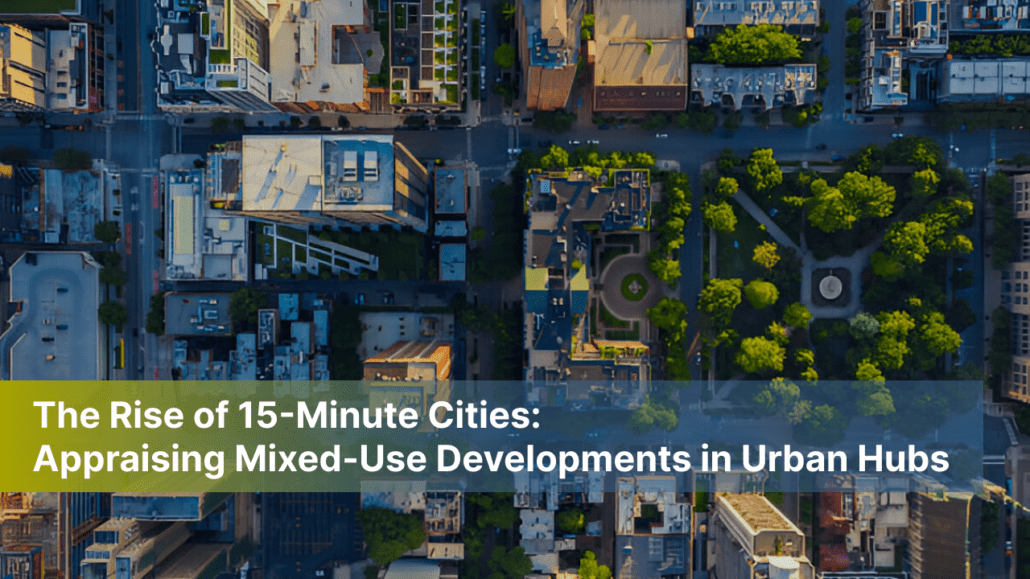Table of Contents
Imagine living in a neighborhood where everything you need—workplaces, schools, grocery stores, parks, and even your favorite coffee shop—is just a short walk or bike ride away. This concept, known as the 15-minute city, is reshaping urban planning worldwide. The goal is simple: build communities where convenience and connection come first.
For homeowners, buyers, lenders, attorneys, and real estate agents, the rise of these neighborhoods offers exciting opportunities. But with mixed-use developments at their core, the appraisal process becomes more nuanced. Let’s explore what makes these developments in 15-Minute Cities unique and why accurate valuations matter.
What Is a 15-Minute City?
The 15-minute city is a forward-thinking approach to urban living. It focuses on creating neighborhoods where everything needed for daily life—shopping, education, work, and recreation—is within a 15-minute radius of home. These areas prioritize walking, biking, and public transit over car dependency, creating greener, healthier communities.
Central to these cities are mixed-use developments, which blend residential, commercial, and sometimes recreational spaces into one cohesive community. Imagine an apartment complex with a grocery store on the ground floor, offices next door, and a park just a block away. It’s urban living, reimagined for convenience and sustainability.
Massachusetts: A Leader in 15-Minute Cities
Massachusetts is at the forefront of adopting the 15-minute city model. Several neighborhoods and projects showcase how this vision is becoming a reality:
- Assembly Square, Somerville
What was once an industrial area is now a vibrant community. Assembly Square features apartments, restaurants, shops, and parks, all within easy reach. Residents can enjoy a meal, run errands, or take a stroll along the waterfront—all without needing to drive. - Seaport Square, Boston
Boston’s Seaport Square has been designed with thought and care, combining homes, office spaces, retail shops, and open green areas. It’s not just a place to live; it’s a place where work, relaxation, and community come together seamlessly. - Southfield, Weymouth
Built on the former South Weymouth Naval Air Station, Southfield is a modern suburban development with housing, retail spaces, walking trails, and recreational facilities. It’s a perfect example of a self-contained community designed for both convenience and quality of life. - Boston’s Neighborhood Vision
Beyond these individual projects, Boston is working to create more walkable, accessible neighborhoods citywide. By improving public transportation and enhancing local amenities, the city is paving the way for a more connected urban future.
Appraising Mixed-Use Developments: A Specialist’s Perspective
For appraisers, properties in 15-minute cities bring exciting opportunities—but they also require a deeper level of expertise. Mixed-use developments don’t fit into traditional appraisal models, so understanding their complexities is key.
Tailored Insights for Each Audience
- Homeowners and Buyers: For those living in or purchasing property in a mixed-use development, the value goes beyond size and location. It’s about lifestyle, accessibility, and convenience. Appraisers help you understand what your investment is truly worth.
- Lenders and AMCs: Mixed-use properties often have diverse revenue streams, from residential leases to commercial rentals. Appraisers provide a detailed analysis of each component to ensure accurate valuations that support sound lending decisions.
- Real Estate Agents: Highlighting the unique appeal of these developments—whether it’s proximity to parks, sustainable design, or vibrant community spaces—is essential. Appraisers deliver data-driven insights that help agents showcase these properties effectively.
- Attorneys and Lawyers: In legal scenarios like disputes, estate planning, or transactions, appraisers offer unbiased valuations that ensure clarity and support successful outcomes.
What Appraisers Consider in Mixed-Use Developments
- Diverse Property Types
Mixed-use developments often include residential, retail, and office spaces, each with unique valuation methods. For instance, retail spaces might be appraised based on income potential, while residential units rely on comparable sales. - Location and Accessibility
In 15-minute cities, location is a defining feature. Proximity to schools, public transit, parks, and shopping significantly impacts property value. Appraisers analyze how these elements attract demand and enhance livability. - Sustainability Features
Many developments focus on eco-friendly designs, like energy-efficient systems or green roofs. These features can enhance market appeal but require appraisers to evaluate how they align with buyer preferences and market trends. - Market Dynamics
With demand for walkable neighborhoods growing, appraisers assess how these trends influence pricing and long-term investment potential.
Why Accurate Appraisals Matter
An accurate appraisal is essential for everyone involved in real estate. For buyers, it ensures you’re making a sound investment. For lenders, it provides the foundation for smart financing decisions. And for developers, it offers insights into how a project’s design and location influence its market value.
In neighborhoods designed around the 15-minute city model, appraisers play a critical role in capturing the full picture of a property’s worth. This ensures that the value reflects both the physical property and the lifestyle it supports.
The Future of 15-Minute Cities
The rise of 15-minute cities is reshaping how people live, work, and connect with their surroundings. In Massachusetts, developments like Assembly Square and Seaport Square show how this vision can become a reality. These neighborhoods offer more than convenience—they provide a better quality of life while supporting sustainability and community.
For homeowners, buyers, lenders, and professionals, understanding these neighborhoods is essential. As these developments continue to grow, appraisers will remain at the heart of this transformation, ensuring that innovation and value go hand in hand.
You can click here to watch a video. For more information, please click here to contact us.




Add your first comment to this post